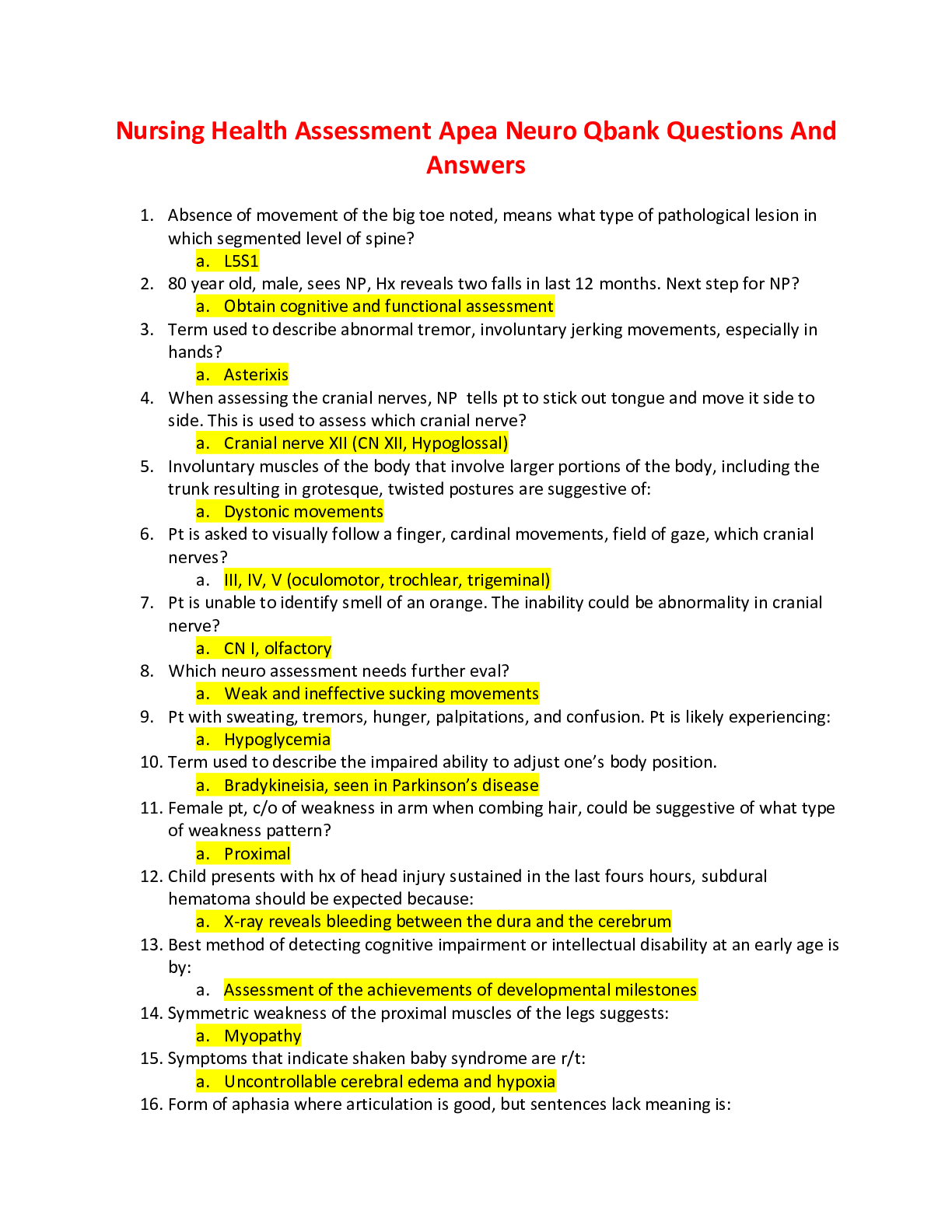Psychology > EXAM > PYC3703 Test bank Questions and Answers (500+) | PYC3703 Test bank 12 chapters (All)
PYC3703 Test bank Questions and Answers (500+) | PYC3703 Test bank 12 chapters
Document Content and Description Below
PYC3703 Test bank Questions and Answers (500+) PYC3703 Test bank Questions and Answers 12 chapters Chapter 1 TEST BANK 1. Which of the following would not be studied by a Cognitive Psychologist? ... a. whether people can pay attention to multiple stimuli at once without losing accuracy b. if advertising using animation is more memorable than advertising using no animation c. whether a group of people present affect how much is given to charity d. if the reading speed of college graduates differs from that of high school graduates ANS: c 2. The combination of rational with empirical methods so as to get the “best of both worlds” represents, in dialectical terms, a(n) a. thesis. b. antithesis. c. synthesis. d. antisynthesis. ANS: c 3. Part of dialectic thinking is when a statement of belief is proposed. This statement would be called the . a. antithesis b. synthesis c. thesis d. pragmatics ANS: c 4. This part of dialectic thinking is when a counterstatement to previous beliefs emerges. This counterstatement would be called the . a. antithesis b. synthesis c. thesis d. pragmatics ANS: a 5. The philosopher who advanced the notion of a dialectic was . a. Plato b. Hegel c. Descartes d. Aristotle ANS: b 6. A rationalist a. uses logical analysis to understand the world and people’s relations to it. b. is a follower of Aristotle’s empiricist philosophy. c. supports the idea of monism. d. believes that knowledge is acquired through experience and observation. ANS: a 7. Rationalism is to as empiricism is to . a. empirical evidence; theory b. theory; empirical evidence c. manipulation; measure d. hypothesis; theory ANS: b 8. This particular approach emphasizes logical analysis as the means to acquiring new knowledge. a. Tabula rasa b. Synthesis c. Rationalist d. Empiricist ANS: c 9. An empiricist a. believes that knowledge is acquired through experience and observation. b. is a follower of Plato’s rationalist philosophy. c. supports the idea of mind-body dualism. d. believes that the mind and the body are separate entities. ANS: a 10. This particular approach emphasizes empirical evidence as the means to acquiring new knowledge. a. Rationalist b. Monist c. Empiricist d. Nativist ANS: c 11. Theresa, a judge, does not accept circumstantial evidence as evidence in her court. Theresa will not convict anyone of a crime, based on general principles of anticipated behavior of people brought to court. Instead, Theresa allows only evidence that she can see, or “hard,” observational evidence, to be used in a prosecution. Theresa could be referred to as a(n) a. Monist b. Empiricist c. Rationalist d. Nativist ANS: b 12. Elma, an automobile factory worker, learns how to install a car air conditioner by watching a fellow worker install the part. The knowledge Elma has just acquired is acquired knowledge. a. experimentally b. reductively c. innately d. empirically ANS: d 13. Psychology is sometimes viewed as a merging of a. philosophy and monism. b. rationalism and physiology. c. physiology and empiricism. d. philosophy and physiology. ANS: d 14. Descartes is known for having been a(n) a. functionalist. b. behaviorist. c. empiricist. d. rationalist. ANS: d 15. A philosopher who largely rejected acquisition of knowledge by empirical means was a. John Locke. b. Aristotle. c. David Hume. d. René Descartes. ANS: d 16. Which of the following people supported the rationalist view and largely rejected the pure empirical view? a. Kant b. Aristotle c. Descartes d. Locke ANS: c 17. refers to Locke’s belief that all knowledge is gained empirically, beginning at birth, when our minds are a blank slate. a. Innate b. A priori c. A posteriori d. Tabula rasa ANS: d 18. Immanuel Kant a. believed in an integration of rationalism and empiricism. b. rejected completely all forms of rationalism and empiricism. c. believed only in rationalism. d. believed only in empiricism. ANS: a 19. The goal of structuralism was to understand the “content” of the mind by a. synthesizing constituent parts of perceptions. b. analyzing perceptions into their constituent parts. c. observing responses to various stimuli. d. evaluating other schools of thought to provide a “structure” for the new movement. ANS: b 20. Wilhelm Wundt’s idea of involved looking inward at the contents of one’s consciousness. a. projection b. introversion c. repression d. introspection ANS: d 21. Bill, a mechanic, believes that automobile research should place an emphasis on studying how a car is used and the processes that occur among the various parts. If Bill had chosen psychology as a career field, he might have been in favor of a. Gestaltism. b. structuralism. c. behaviorism. d. functionalism. ANS: d 22. Which of the following examples is most analogous to the goal of the structuralist movement? a. Scientists study an entire assembled jigsaw puzzle in order to understand each of the pieces. b. Scientists look at how the pieces of a jigsaw puzzle fit together in order to understand the assembling process. c. Scientists look at each piece of a jigsaw puzzle in order to understand the whole puzzle as assembled. d. Scientists study the different ways a jigsaw puzzle can be assembled to form different images. ANS: c. 23. The school of thought that focuses on answering the question of “What do people do and why do they do it?” is called a. Gestaltism. b. structuralism. c. psychoanalysis. d. functionalism. ANS: d 24. Which of the following is not consistent with the ideas of functionalism? a. the study of the organism independent of its environment b. the study of mental processes c. the study and uses of consciousness d. the study of the relationship between the organism and its environment ANS: a 25. Lorraine was conducting an experiment in which she was eating an apple and was trying to analyze the experience. What technique was she using? a. in vivo b. introspection c. empiricism d. naturalistic observation ANS: b 26. A leader in guiding functionalism toward pragmatism was , whose chief functional contribution to the field of psychology was his landmark book, Principles of Psychology. a. John Dewey b. William James c. Edward Lee Thorndike d. Hermann Ebbinghaus ANS: b 27. Pragmatism concerns itself most directly with the a. practicality of acquiring knowledge. b. degree to which knowledge is empirical. c. philosophical implications of knowledge. d. usefulness of knowledge. ANS: d 28. Of the following types of knowledge, a pragmatist would most likely support the study of knowledge that a. exists for its own sake. b. can be used to help people become better educated. c. enables us to speculate further on the relationship between body and mind. d. has no specific use, but is highly interesting from a psychological perspective. ANS: b 29. Associationism is a school of psychology, arising from Locke and Aristotle, that examines a. how ideas become associated with each other in the mind. b. the process by which the thoughts of some people associate with the thoughts of others. c. how “nonreal” representative objects become associated with abstract “ideal” objects in the mind. d. observable associations between stimuli and responses. ANS: a 30. This researcher examined the impact of rehearsal on memory using himself as a subject. a. Tolman b. Dewey c. Kant d. Ebbinghaus ANS: d 31. The “law of effect” states that a stimulus will tend to produce a certain response over time if the a. stimulus is conditioned. b. organism is repeatedly rewarded for that response. c. organism is repeatedly punished for that response. d. stimulus and the response are both unconditioned. ANS: b 32. The landmark experiment in which dogs salivate at the sight of the person who feeds them provides an example of a. classically conditioned learning. b. instrumental learning. c. social learning. d. physiological psychology. ANS: a 33. Skinner’s argument included the idea of operant conditioning, which refers to his belief that a. the strengthening or weakening of behavior, depending upon the presence or absence of reinforcement or punishment, explains all human behavior. b. all human behavior can be explained by operant conditioning, involving the strengthening or weakening of behavior, depending only on the presence of punishment. c. human behavior is highly unpredictable and, as a result, only some human behavior can be explained in terms of reinforcement-punishment relationships. d. human behavior cannot be understood without taking into account the purpose of the behavior. ANS: a 34. John Watson, the founder of radical behaviorism, was an American psychologist who a. rejected all aspects of functionalism. b. supported the functionalist movement and was one of its most ardent supporters. c. rejected some aspects of functionalism, but at the same time drew heavily from the functionalists. d. altered the course of functionalism and later renamed the movement “behaviorism.” ANS: c. 35. Which of the following is a legitimate criticism of Behaviorism? a. The behavioristic principles did not explain language learning well. b. The law of effect did not generalize to humans. c. Classical conditioning only works on animals. d. All of the above are legitimate criticisms. ANS: a 36. Gestalt psychology has most greatly influenced, specifically, the study of a. emotion. b. insight. c. behavior. d. linguistics. ANS: b. 37. Which of the following were known as Behaviorists who were willing to look inside the black box? a. Tolman for his work with mazes b. Pavlov for his work with dogs. c. Skinner for his work with rats. d. Watson for his work with Little Albert. ANS: a 38. Karl Lashley’s work in biological psychology led him to work with which key issue that deals with the location of individual cognitive processes in the brain? a. Monistic localization in brain function b. Prosopagnosia c. The brain as an organizer of behavior d. Hysteresis ANS: c 39. When developing this type of computer system, the goal is to have a system thatdemonstrates intelligent processing of information. a. Artificial Intelligence b. Engineered Intelligence (EI) c. Technologically Engineered Intelligence (TEI) d. Information processing approach ANS: a 40. Who is known for the development of the concept “modularity of the mind”? a. B.F. Skinner b. Jerry Fodor c. Albert Bandura d. Donald Broadbent ANS: b 41. What does the term metacognition refer to? a. It is a term that describes all the different theories of Intelligence. b. The term describes the mathematical process used to calculate intelligence. c. The term describes your understanding of your own thinking processes. d. The term captures the cultural differences in intelligence. ANS: c 42. Which theory of Intelligence emphasizes modularity? a. Carroll: Three-Stratum Model of Intelligence b. Gardner: Theory of Multiple Intelligences c. Sternberg: The Triarchic Theory d. None of the theories emphasize modularity. ANS: b 43. Christia is in the process of developing a research idea. She currently is reviewing various , which consists of explanatory principles for the phenomenon of interest. a. correlational studies b. dependent variables c. hypotheses d. theories ANS: d 44. After conducting an experiment, the means for the two groups are not identical which may suggest a difference between the two groups. However, in order to be sure, you need to analyze the experimental results in terms of the likelihood that the result simply occurred by chance. This is called a. statistical significance. b. practical significance. c. descriptive statistics. d. meta-analysis. ANS: a 45. Dorothy conducted an experiment in which there was a 20 point difference between the experimental and control group. The statistical test suggests that this result did not occur simply by chance. Dorothy’s results are said to have (found) a. statistical significance. b. practical significance. c. descriptive statistics. d. meta-analysis. ANS: a 46. In an experimental design, this is often the variable of interest that is being manipulated. a. extraneous variable b. independent variable c. dependent variable d. confounding variable ANS: b 47. In an experimental design, this is often the outcome or the variable that is being measured(e.g., score on a test). [Show More]
Last updated: 1 year ago
Preview 1 out of pages
Instant download

Buy this document to get the full access instantly
Instant Download Access after purchase
Add to cartInstant download
Reviews( 0 )
Document information
Connected school, study & course
About the document
Uploaded On
Jun 17, 2020
Number of pages
Written in
Additional information
This document has been written for:
Uploaded
Jun 17, 2020
Downloads
0
Views
8













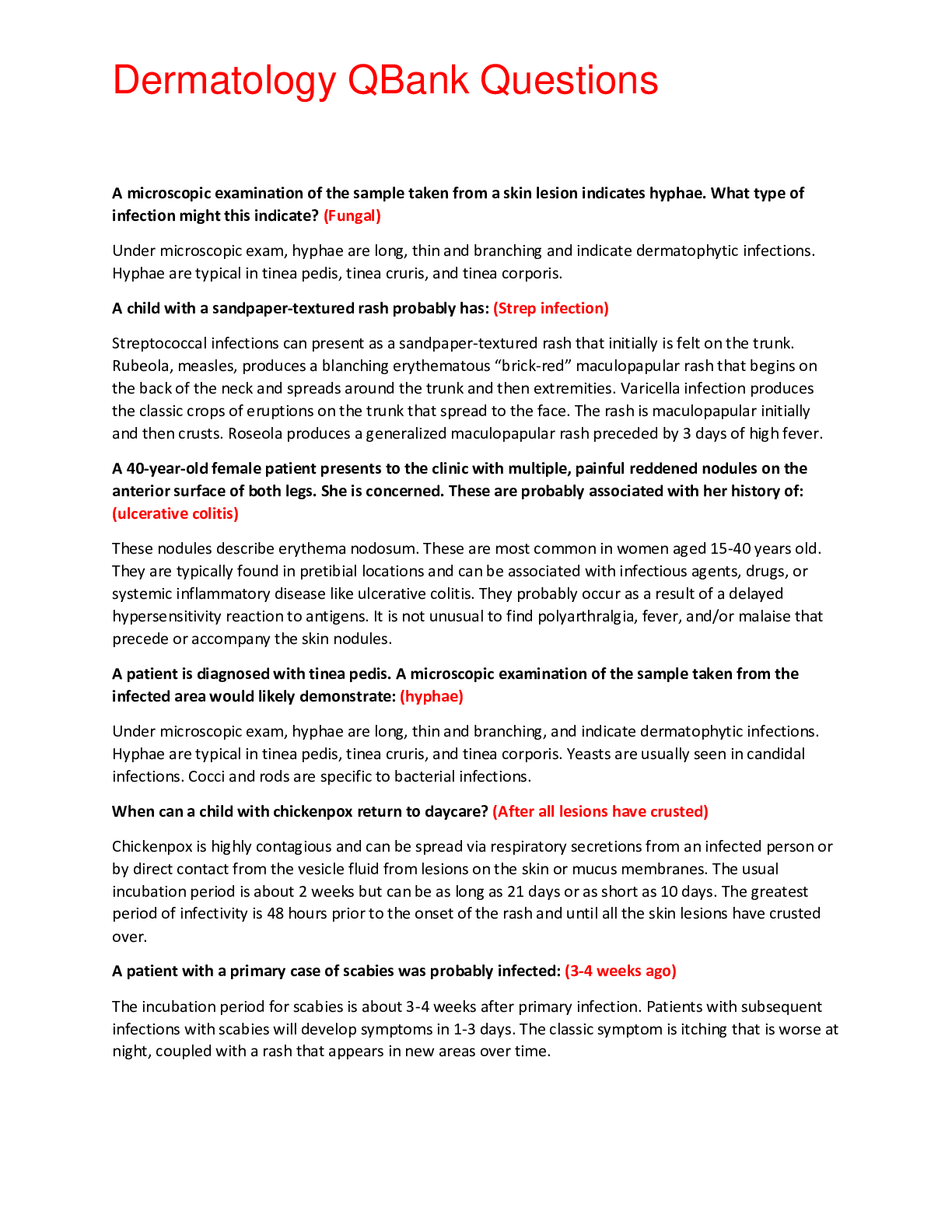

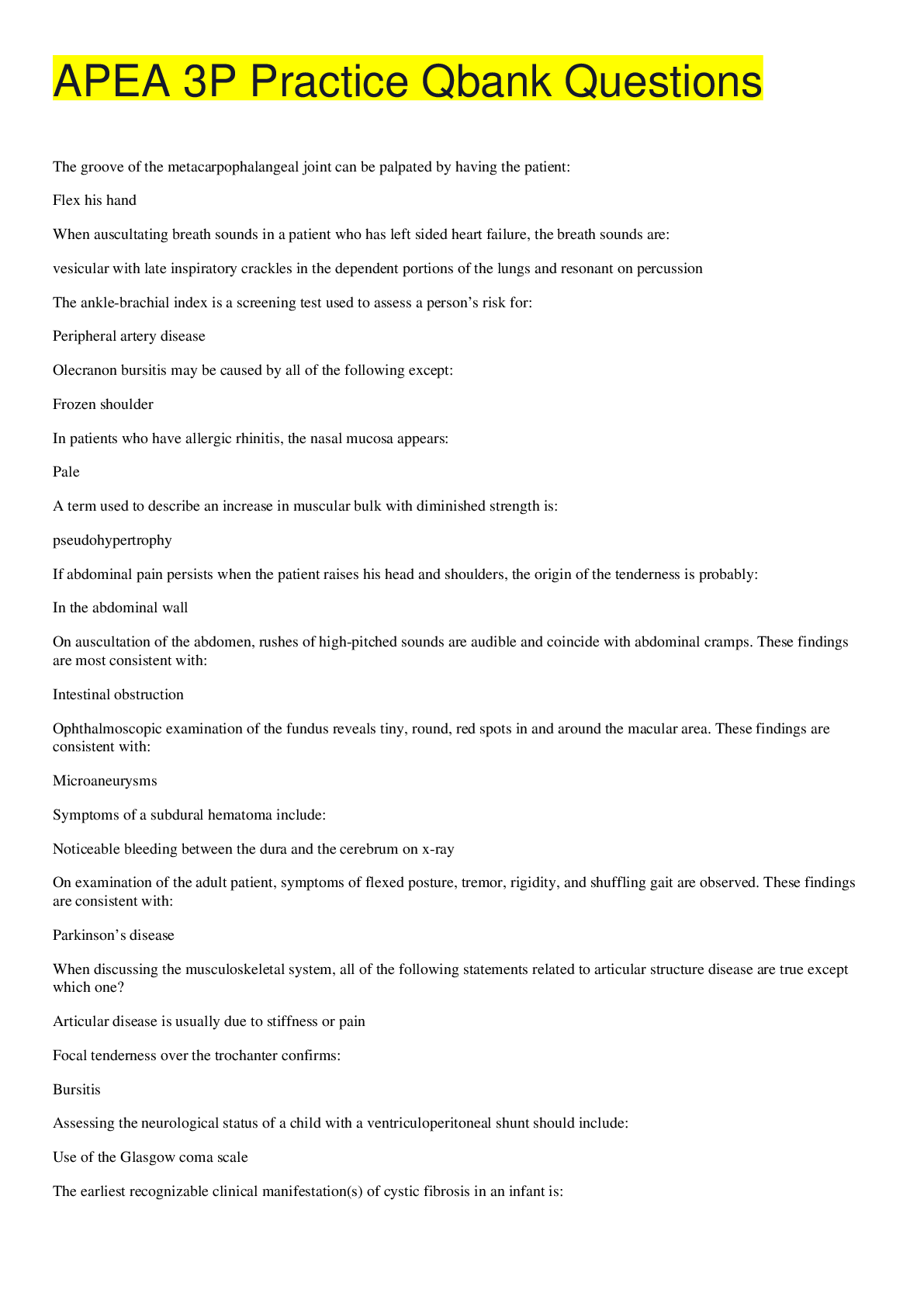

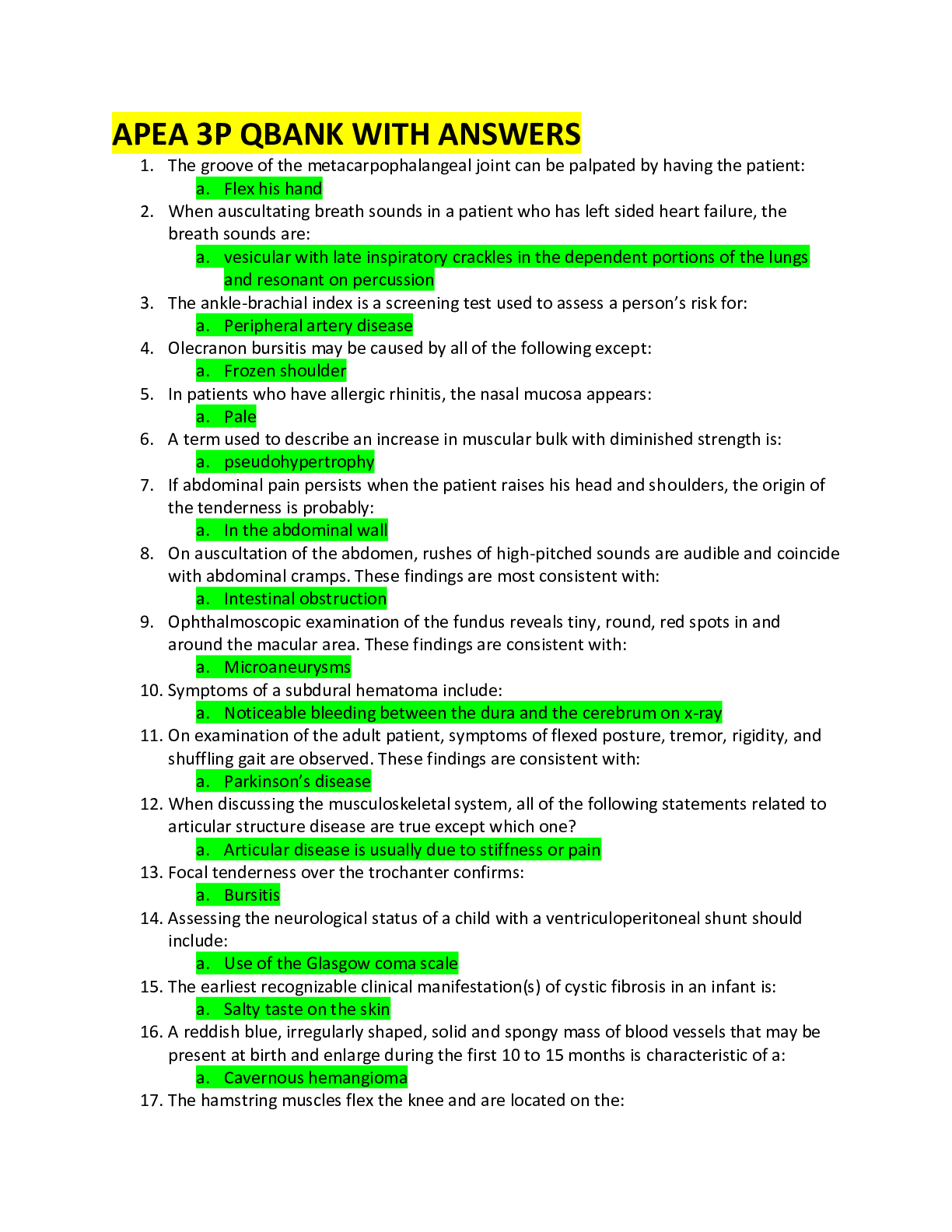
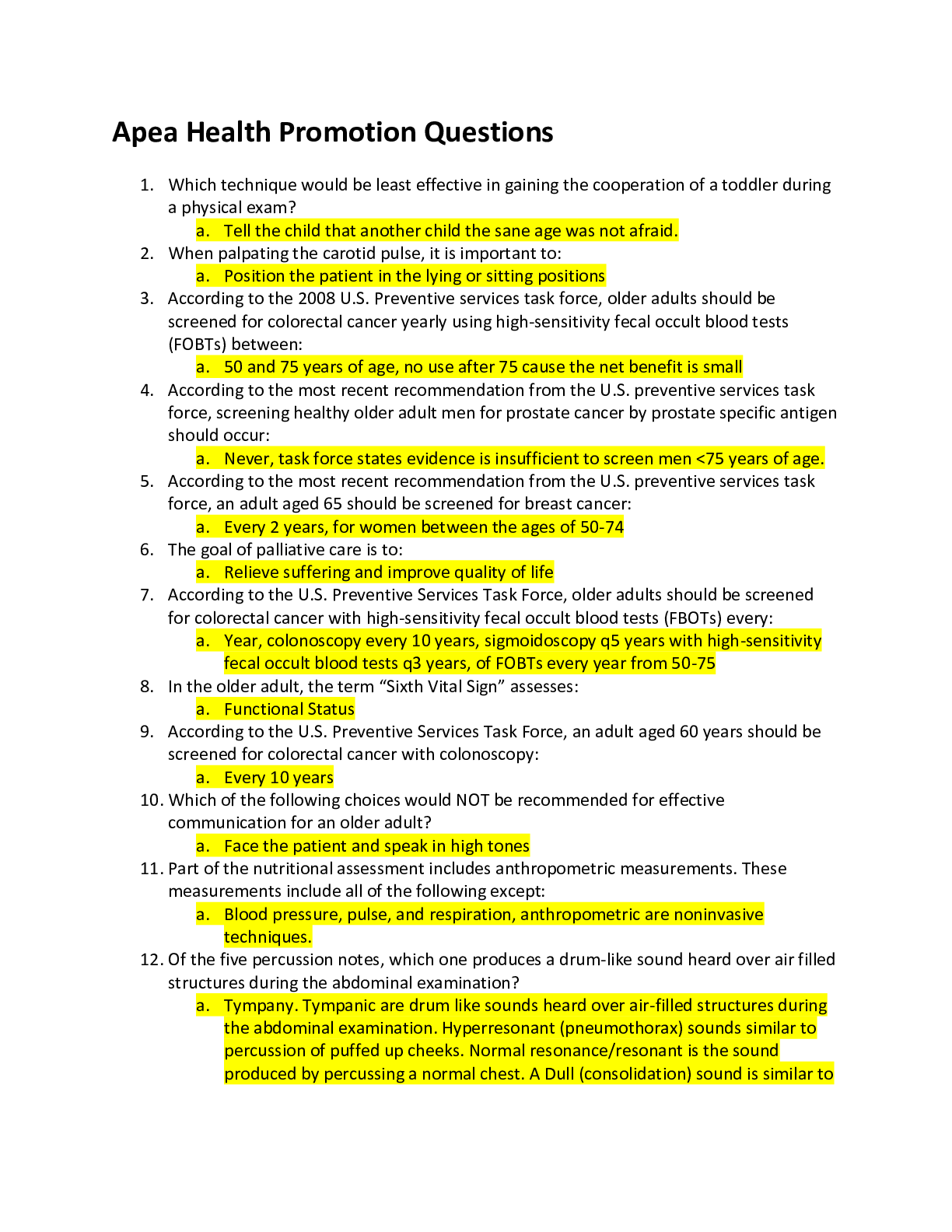
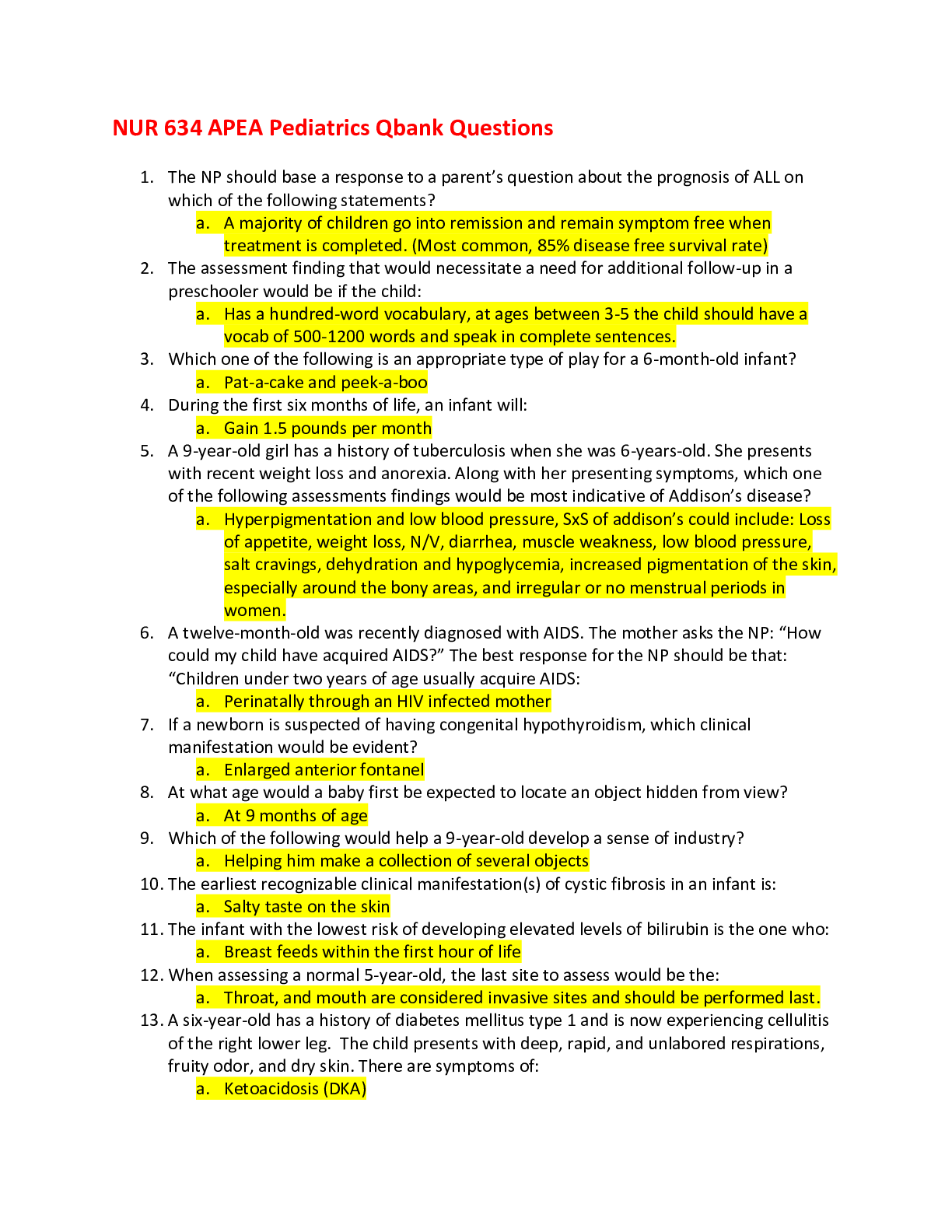
.png)

